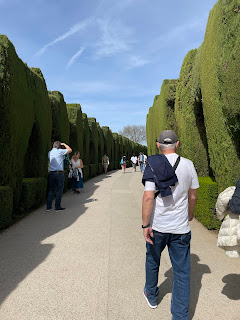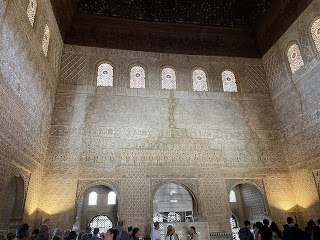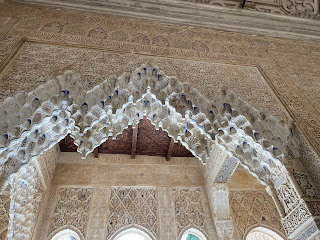 |
This is the view of and from my balcony.
|
This morning was my morning to sleep in. The only thing on my must do list was visit the Alhambra, so I slept in until 10:00 and was out the door by 11:00. After getting so tired yesterday, I decided to take the bus. Also, I twisted my ankle on a loose board on my hike and my ankle is fine but my knee hurts now. So for my lungs and my knee, I took a bus. I saw the right number before I got to the right plaza so I jumped on and asked Alhambra? Yes, so I paid and we went! The buses they use for the center of the city are mini buses--they are so cute! We were in a mini bus to go up there. I stopped on my way to the bus to buy a chocolate croissant--my first "breakfast" of my trip! I had a handful of nuts while walking around--they have signs that say "No Eating" (except in Spanish)--everywhere at the Alhambra (yet they have a few souvenir shops that sell ice cream and snacks-hmmm).
The Alhanbra was huge, but way better organized than the Real Alcazar in Seville. It is divided into four areas, each with signs in a different color. My tickets for the Palacios Nazarines were for 1:00 and they are VERY strict about that. So I had a few hours and went to the first area--the Generalife--the summer palace and country estate of the Nasrid rulers of the Emirate of Granada in Al-Andalus built in the 14th century. Every small room led onto a courtyard or garden, so a lot of it was outside. Generalife is translated from the Spanish as "garden of paradise", "orchard" or "garden of feasts". You first walk through fields (rooms) of gardens. They are currently working on the gardens to reclaim and regrow the cypress trees and plants that were not taken care of (to form the borders and topiary)--years of neglect and renovations. Many have fountains in them and several have irrigation canals. Water is very important to the Islamic culture, Muslims drink water for protection, for blessing, and for cure. It is used at weddings to bless the bride and groom, for mothers after giving birth, and for babies and sick people. The hydraulic system in the Alhambra depends on the Sultan's Canal, which carries water from the Darro River to the Generalife, and from there, by aqueduct, to the Alhambra.
 |
| Part of the aqueduct right by the entrance |
 |
| Cypress archways |
 |
| The gardens leading to the palace |
 |
| A view of the Alcazaba |
 |
| Inside the palace |
 |
| me! With Alcazaba in the background |
 |
Those windows at the top are carved and
the ceiling is inlaid wood |
 |
| water flowing even in the walls and handrails |
 |
| wisteria |
After leaving the Generalife, you walk toward the Palacio Nazaries and the Alcazaba--a 15 minute walk. In that area is the Convento de San Francisco. When Spain was conquered by the Christians, they gave Granada to the Franciscans. So they set up their convent in one of the palaces vacated by the Nazarines. The palace they chose also contained the Muslim baths (similar to Turkish baths, but related to the beliefs of Islam). It is now being used as a hotel.
 |
| Honeycomb ceilings |
 |
| skylights in the baths |
 |
| One of the baths |
There were streets in the complex, now the old shops are filled with tourist-type of shops.
Now it was nearly time for the Nasrid Palace so I sat in a courtyard to wait for the last 15 minutes. Then I went to get in line and realized that it was the line for the Alcazaba. So I had to retrace my steps and saw a worker pointing another couple in the right direction. There are signs with arrows for each palace, but they are not very clear. So I finally went into the palace. Lots of courtyards and beautiful tile work. (Get ready--lots of photos!)
 |
| Wooden ceiling inlaid with ceramic. |
 |
| Partially painted wooden beam. |
 |
| Wooden floor inlaid with tiny ceramic tiles. |
 |
| Beautiful tile work |
 |
| Inlaid ceiling |
 |
| Carved arch |
 |
| Close up of a tile written in Arabic(?) |
 |
| Ceiling |
 |
| Courtyard with reflecting pool and fountain |
 |
| Ceiling |
 |
| Notice the carved windows |
 |
| Such detail! |
 |
| Again, carved screens |
 |
| Wonder where those go to? |
 |
| Courtyard |
 |
Painted ceiling of a battle. The person in the
carriage seems quite pleased with how it is going. |
 |
| Water bisects the courtyard |
 |
This is the fountain of the lions. The lions show the
might of the King. |
 |
| stained glass ceiling |
 |
| Another courtyard, this with trees and bushes |
 |
| These are the skylights of the baths (we didn't get to see the baths) |
 |
| The courtyard from before |
 |
| Orange Trees |
 |
| These trees look like popsicles! |
 |
| Interesting topiary |
 |
| This courtyard has a pool filled with koi |
 |
| A water channel running down the center of the steps |
After the Palace, I went to the Alcazaba (which in Arabic means fortress). It was not quite as fancy as the palace, but it is for the soldiers and for defense.
 |
| I love this face! |
 |
The barrio, or neighborhood where the higher ranking
soldiers who were tasked with protecting the King lived. |
 |
| The outer walls on the edge of the hill |
 |
| More of the upper level soldiers' quarters |
 |
The walls
|
 |
This is the koi in the pool from the previous section. The
software won't let me put it where it is supposed to go. |
After the Alzcaban, there was only one more building that I saw, the Palacio de Carlos V which also houses the Museum of Alhambra and the Museum of Bellas Artes. The museums are upstairs so there is very little to look at other than the center courtyard and the museums.
After that, I exited and decided to walk back to town. It was all downhill, literally.
I was going back to my hostel to rest my knee but decided to stop in the Plaza Nueva to find lunch. I was looking for a sandwich because it was already past 3:00. I found a cafe selling Turkish sandwiches which sounded really good. I got a falafel sandwich which was very good. It had been quite windy all day which was generally okay because the temperatures were in the mid-80s. As I was eating however, the wind picked up and knocked my glass of soda over (all over my library book that I was reading as I ate) and spilled lettuce and onion from the sandwich that I was eating. I had to hold onto my food as I finished, then as I was waiting for them to clear. I eventually asked for the bill which I had to take inside to pay as he finally cleared my table which kept everything from flying off all over. Then back to my hostel for a rest.
 |
| This is a fountain that has something to do with Napoleon. |
 |
| A stream running all the way down the hill--one on each side of the street. |
 |
A gateway into the old city? Or into the area leading to the
Alhambra (which is now filled with homes). |
After a few hours, I went back out and went to the Silk Market to buy a few things, and decided that since it was 7:30 I should probably get dinner. When I checked in my hostel yesterday, the woman said that if you buy a drink at one of the bars, you receive a complimentary tapas. So, I decided to celebrate my last day in Andalusia with a glass of wine. The complimentary tapas was brought over and it was a small ham sandwich and Fritos! Ha-ha, how weird! Everyone else in the bar was receiving the same tapas. I'm not sure how other bars handle it. I think, generally, tapas is better shared with others, where you can order several foods and share them. Tomorrow is a very early train. It's going to be hard sleeping though. Even though I finally closed the balcony doors, I can still hear the people at the bar down below. I am in the old town with the warren of small streets. My favorite part of any city.

































































































No comments:
Post a Comment